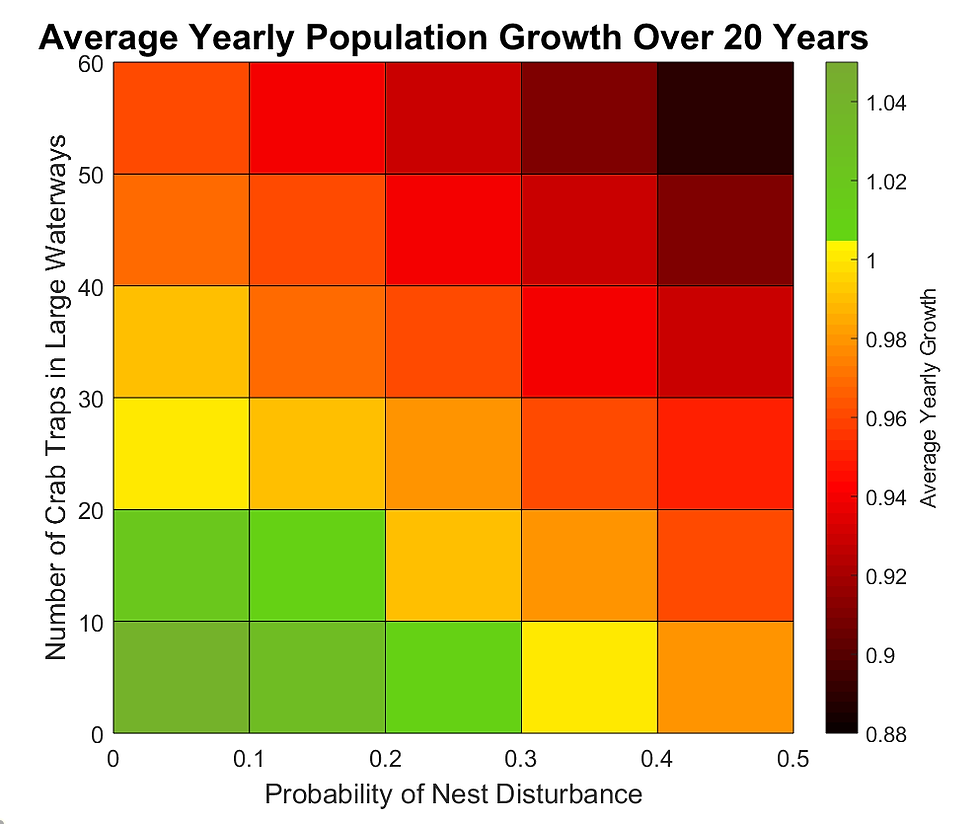Assessing Threats to Diamondback Terrapins in a Coastal Carolina Salt Marsh.
- Benjamin Levy
- Jan 21, 2019
- 2 min read
Updated: Jan 25, 2022
This project was conducted in the summer of 2018 with a senior mathematics major. This work was published in Mathematical Biosciences.
Overview
Diamondback terrapins (Malaclemys terrapin) live in estuarine habitats along the Atlantic and Gulf coasts of the United States. Populations in many locations are declining due to increased nest destruction and drowning in crab traps. Using data collected by collaborator Dr. John Ludlam, we developed three models to evaluate these threats and consider the conditions needed for terrapins in South Carolina to persist.
We first developed a matrix model that includes both sexes with age classes partitioned by size since smaller terrapins, especially males, perish in crab traps at a higher rate. This can lead to the sex-ratio of the population becoming skewed towards females. By adjusting the class-specific survival rates in the two-sex model to reproduce collected data, we use the two-sex model to establish how the presence of crab traps can skew the sex-ratio of the population over time. The second matrix model we formulated only considers females in the population using the three classes that best represent the life cycle of the species. By only including females, we are able to reduce the number of parameters in the model. This allowed us to more easily identify factors that are key to the population by conducting an elasticity analysis for parameters with respect to the long-term growth rate of the population, (see image 1 below). Using these models, we can also establish a threshold of the level of crab traps that can be allowed before the population begins to decline.

Image 1: Elasticity Analysis of Matrix Model Environment
The third model we developed is a stochastic agent-based model. While the non-spatial, deterministic matrix models can provide interesting insights into population dynamics, our stochastic agent-based model allows us to explicitly model space and incorporate variability in our simulations. We recreate the exact environmental conditions from the study area by uploading a GIS shapefile for the study area into Netlogo (see image 2). Individual behavior was coded to produce observed population-level dynamics, including the tendency for individuals to remain near a specific home creek, females returning to the same nesting location each year, and the brumation process. Since our agent-based model is computationally expensive we partnered with the Massachusetts Green High Performance Computing Center (MGHPCC) to run thousands of simulations on their supercomputer. We use this spatial model to consider how an increase in the number of crab traps, frequency of nest disturbances, and the geographic placement of traps impact the long-term viability of diamondback terrapins (for example, image 3 below).


Image 2: Agent-based Model Environment
Image 3: Sample Output from Agent-Based Model
This paper was published in Mathematical Biosciences. Results from this project improve our understanding of diamondback terrapins in general and guide conservation efforts in South Carolina and similar locations.

Comments